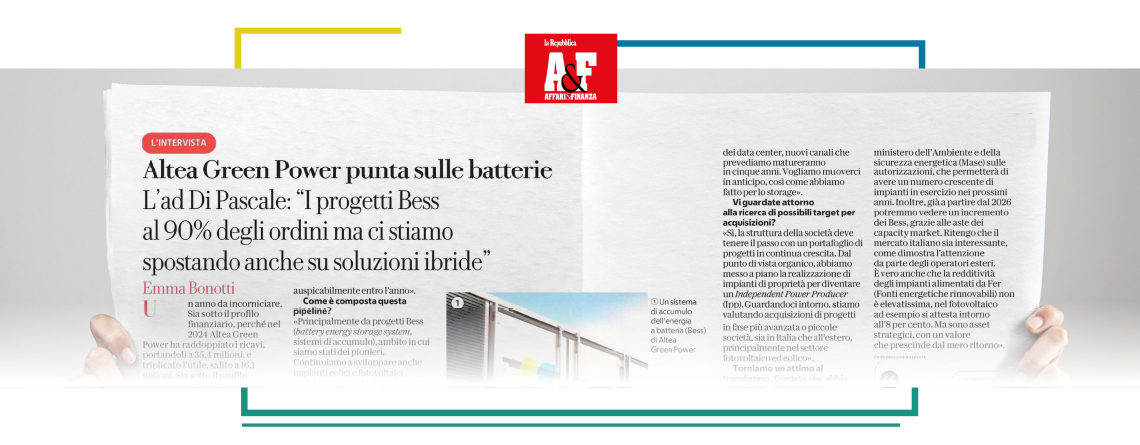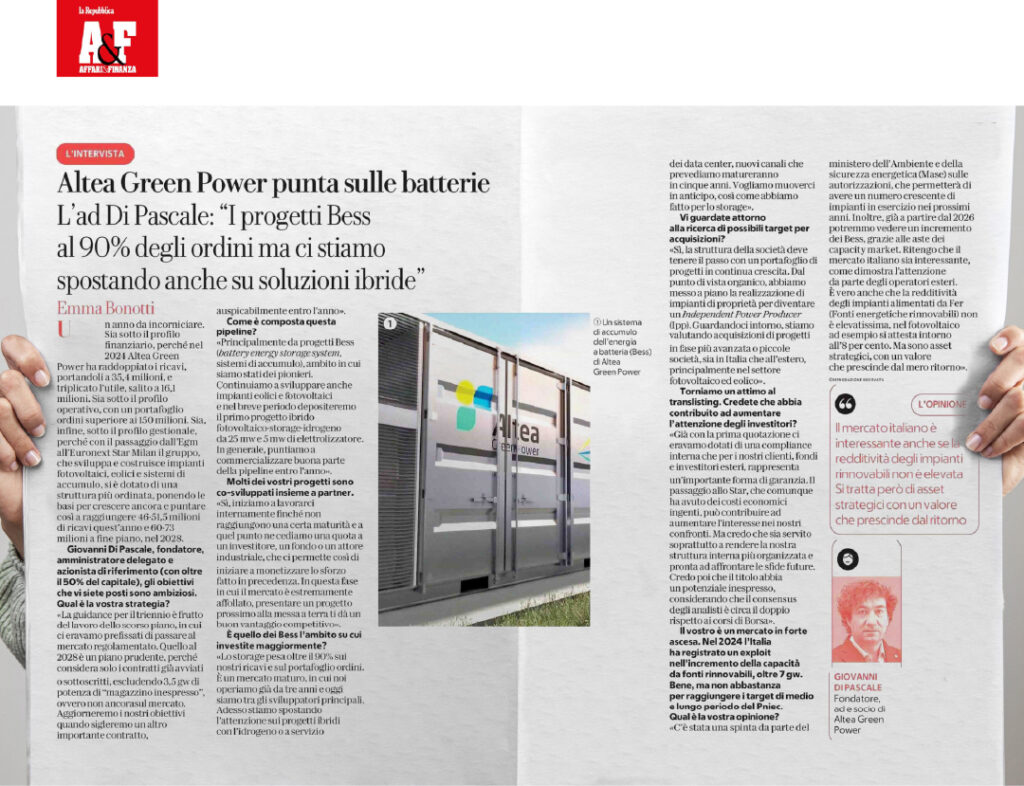Today, our CEO Giovanni Di Pascale discusses the BESS market and the company’s ambitious plans in Affari&Finanza of La Repubblica.
Preview of the interview by journalist Emma Bonotti
[..] It’s a standout year for Altea Green Power. Both financially, as revenue doubled to € 35.4 million and profit tripled to € 16.1 million in 2024. And operationally, with an order backlog exceeding € 150 million. [..] Storage accounts for over 90% of both revenue and the order backlog. It is a mature market in which we have been operating for three years, and today we are among the leading developers. We are now shifting our focus to hybrid projects.
Q&A excerpts from the interview
Giovanni Di Pascale, founder, CEO, and majority shareholder (with over 50% of the share capital), your goals are ambitious. What is your strategy?
The guidance for the three-year period is the result of the previous plan, where we aimed to move to the regulated market. The plan to 2028 is conservative, as it considers only contracts already started or signed, excluding 3.5 GW of “unexpended inventory power”, meaning not yet on the market. We will update our targets once we sign another major contract, hopefully within the year.
How is this pipeline composed?
Mainly from BESS (Battery Energy Storage System) projects, an area in which we were pioneers. We also continue to develop wind and photovoltaic plants, and in the short term, we will file the first 25 MW photovoltaic-storage-hydrogen hybrid project and 5 MW electrolyzer. Overall, we aim to market much of the pipeline within the year.
Many of your projects are co-developed with partners.
Yes, we work on them internally until they reach a certain level of maturity, and at that point, we sell a share to an investor, fund, or industry player, allowing us to monetize the effort made earlier. In an increasingly crowded market, presenting a project near completion provides a solid competitive edge.
Is BESS the area in which you invest the most?
Storage accounts for over 90% of our revenue and order backlog. It is a mature market in which we have been operating for three years, and today we are among the leading developers. We are now shifting our focus to hybrid projects with hydrogen or serving data centers, new channels we expect to mature within five years. We want to move early, just as we did in storage.
Are you exploring potential acquisition targets?
Yes, the company’s structure must keep pace with an ever-growing portfolio of projects. From an organic perspective, we plan to build our own plants to become an Independent Power Producer (IPP). At the same time, we are considering acquisitions of more advanced-stage projects or small companies, both in Italy and abroad, mainly in the photovoltaic and wind power sectors.
Let’s go back to the translisting for a moment. Do you think it has helped increase investors’ attention?
Already with the first listing, we had internal compliance in place, which for our clients, funds, and foreign investors, represents an important form of assurance. The transition to the STAR segment, which involved significant financial costs, may contribute to growing interest in us. However, I believe it has primarily helped make our internal structure more organized and prepared to face future challenges. I also believe the share has untapped potential, considering that analysts' consensus is approximately twice the current share price.
Yours is a booming market. In 2024, Italy experienced a surge in renewable capacity, exceeding 7 GW. Good, but still not enough to meet the medium- and long-term targets set by the PNIEC. What is your opinion?
The Ministry of Environment and Energy Security (MASE) has stepped up efforts on permitting, allowing an increasing number of plants to become operational in the coming years. Additionally, as early as 2026, we could see growth in BESS, driven by capacity market auctions. I believe the Italian market is attractive, as shown by the interest from foreign players. Plants powered by FER (Renewable Energy Sources) offer limited profitability - around 8% in photovoltaics, for example. However, these are strategic assets, valued beyond mere returns.




